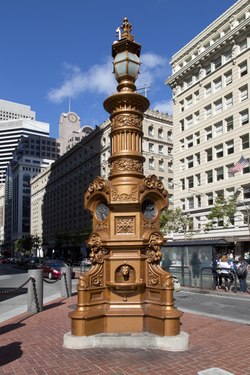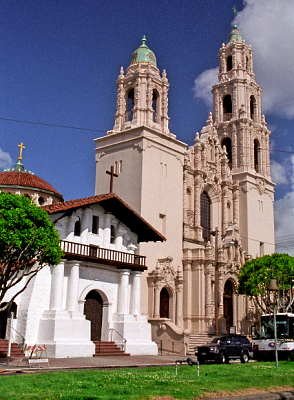
The Mission San Francisco de Asís, also known as Mission Dolores, is a historic Catholic church complex in San Francisco, California. Operated by the Archdiocese of San Francisco, the complex was founded in the 18th century by Spanish Catholic missionaries. The mission contains two historic buildings:
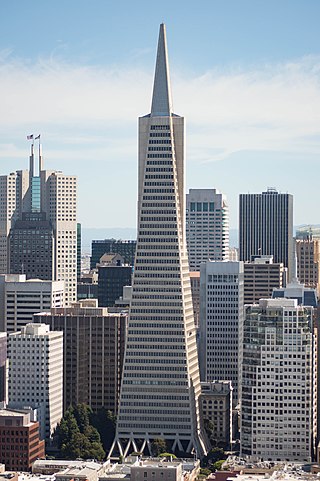
The Transamerica Pyramid is a pyramid-shaped 48-story modernist skyscraper in San Francisco, California, United States, and the second tallest building in the San Francisco skyline. Located at 600 Montgomery Street between Clay and Washington Streets in the city's Financial District, it was the tallest building in San Francisco from its completion in 1972 until 2018 when the newly-constructed Salesforce Tower surpassed its height. The building no longer houses the headquarters of the Transamerica Corporation, which moved its U.S. headquarters to Baltimore, Maryland. The building is still associated with the company by being depicted on the company's logo. Designed by architect William Pereira and built by Hathaway Dinwiddie Construction Company, the building stands at 853 feet (260 m). On completion in 1972 it was the eighth-tallest building in the world. It is also a popular tourist site. In 2020, the building was sold to NYC investor Michael Shvo, who in 2022 hired Norman Foster to redesign the interiors and renovate the building.

Luisa Tetrazzini was an Italian dramatic coloratura soprano of great international fame. Tetrazzini "had a scintillating voice with a brilliant timbre and a range and agility well beyond the norm...". She enjoyed a highly successful operatic and concert career in Europe and America from the 1890s through to the 1920s. Her voice lives on in recordings made from 1904–1920. She wrote a memoir, My Life of Song, in 1921 and a treatise, How to Sing, in 1923. After retirement, she taught voice in her homes in Milan and Rome until her death.

San Francisco City Hall is the seat of government for the City and County of San Francisco, California. Re-opened in 1915 in its open space area in the city's Civic Center, it is a Beaux-Arts monument to the City Beautiful movement that epitomized the high-minded American Renaissance of the 1880s to 1917. The structure's dome is taller than that of the United States Capitol by 42 feet (13 m). The present building replaced an earlier City Hall that was destroyed during the 1906 earthquake, which was two blocks from the present one.

Charlotte Mignon "Lotta" Crabtree, also known mononymously as Lotta, was an American actress, entertainer, comedian, and philanthropist.

The San Francisco Mint is a branch of the United States Mint. Opened in 1854 to serve the gold mines of the California Gold Rush, in twenty years its operations exceeded the capacity of the first building. It moved into a new one in 1874, now known as the Old San Francisco Mint. In 1937 Mint operations moved into a third building, the current one, completed that year.

Kearny Street in San Francisco, California runs north from Market Street to The Embarcadero. Toward its south end, it separates the Financial District from the Union Square and Chinatown districts. Further north, it passes over Telegraph Hill, interrupted by a gap near Coit Tower.
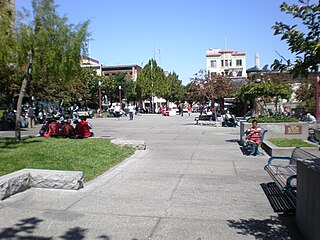
Portsmouth Square, formerly known as Portsmouth Plaza, and originally known as Plaza de Yerba Buena, or simply La Plaza, is a one-block plaza in Chinatown, San Francisco, California. Portsmouth Square is the first park in San Francisco, predating both Washington Square (1847) and Union Square (1850). Established in the early 19th century, during the period of Mexican California, the plaza was renamed following the U.S. Conquest of California in honor of the USS Portsmouth, the American ship which captured the city. It is bounded by Kearny Street on the east, Washington Street on the north, Clay Street on the south, and Walter Lum Place on the west.

The Palace Hotel is a landmark historic hotel in San Francisco, California, located at the southwest corner of Market and New Montgomery streets. The hotel is also referred to as the New Palace Hotel to distinguish it from the original 1875 Palace Hotel, which had been demolished after being gutted by the fire caused by the 1906 San Francisco earthquake.

Rincon Hill is a neighborhood in San Francisco, California. It is one of San Francisco's many hills, and one of its original "Seven Hills". The relatively compact neighborhood is bounded by Folsom Street to the north, the Embarcadero to the east, Bryant Street on the south, and Essex Street to the west. Named after Rincon Point that formerly extended into the bay there, Rincon Hill is located just south of the Transbay development area, part of the greater South of Market area. The hill is about 100 feet tall.
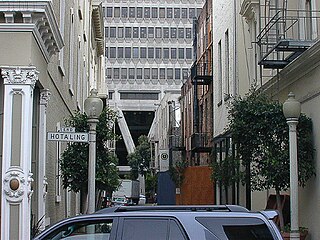
Jackson Square Historic District is an area in downtown San Francisco, California. It dates back to the city's earliest years and the 1849 gold rush, and is known for its historic commercial buildings in the classical revival and Italianate styles.
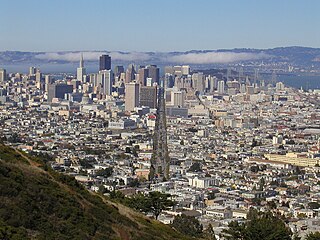
Market Street is a major thoroughfare in San Francisco, California. It begins at The Embarcadero in front of the Ferry Building at the northeastern edge of the city and runs southwest through downtown, passing the Civic Center and the Castro District, to the intersection with Portola Drive in the Twin Peaks neighborhood. Beyond this point, the roadway continues into the southwestern quadrant of San Francisco. Portola Drive extends south to the intersection of St. Francis Boulevard and Sloat Boulevard, where it continues as Junipero Serra Boulevard.

Central Tower is a 91 m (299 ft) 21-story office building at Market and Third Streets in San Francisco, California. The building has undergone numerous renovations since its completion in 1898 as the Call Building. It was later known as the Spreckels Building.
The Home of Lotta Crabtree is located in downtown Grass Valley, California at 238 Mill Street.

At 05:12 Pacific Standard Time on Wednesday, April 18, 1906, the coast of Northern California was struck by a major earthquake with an estimated moment magnitude of 7.9 and a maximum Mercalli intensity of XI (Extreme). High-intensity shaking was felt from Eureka on the North Coast to the Salinas Valley, an agricultural region to the south of the San Francisco Bay Area. Devastating fires soon broke out in San Francisco and lasted for several days. More than 3,000 people died, and over 80% of the city was destroyed. The event is remembered as the deadliest earthquake in the history of the United States. The death toll remains the greatest loss of life from a natural disaster in California's history and high on the lists of American disasters.

The Admission Day Monument is an 1897 sculpture by Douglas Tilden, located at the intersection of Market Street and Montgomery Street in San Francisco, California, United States. It commemorates California Admission Day, the date on which the state became part of the Union, following the Mexican–American War of 1848.

The Mechanics Monument, also known as The Mechanics, Mechanics Statue, or Mechanics Fountain since it originally featured as the centerpiece of a pool of water at the base during the first five years, is a bronze sculpture group by Douglas Tilden, located at the intersection of Market, Bush and Battery Streets in San Francisco, California, United States.

The Ritz-Carlton Club and Residences is a 312-foot (95 m) luxury residential skyscraper in the Financial District of San Francisco, California. The residences are built atop the historic Old Chronicle Building, sometimes called the de Young Building, which was constructed in 1890. It is the first skyscraper built in California.

The Phelan Building is an 11-story office building located at 760 Market Street in the Financial District of San Francisco, California. It has a triangular shape, similar to the Flatiron Building in Manhattan, New York City, with its tip at the meeting point of Market Street, O’Farrell Street, and Grant Avenue. It is a San Francisco Designated Landmark.

The Montgomery Block, also known as Monkey Block and Halleck's Folly, was a historic building active from 1853 to 1959, and was located in San Francisco, California. It was San Francisco's first fireproof and earthquake resistant building. It came to be known as a Bohemian center, from the late 19th to the middle of the 20th-century.
